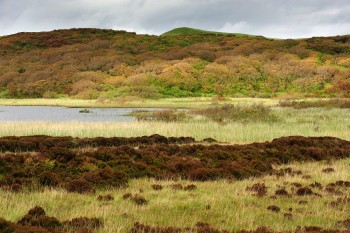Supporting guidance for Habitat Mosaic Management
This is an old version of the page
This is an old version of the page
Date published: 30 March, 2015
Date superseded: 15 December, 2015

Areas of high conservation value often consist of a variety of different wildlife habitats. This option is designed to fund the management of these habitat mosaics.
If the area you intend to manage is predominantly one habitat type, such as species-rich grassland or wetland, then it should be managed under the specific option for that particular habitat.
If the site is a mixture of high wildlife value habitats then this option is likely to be more suitable.
The range of habitats that can be included in a habitat mosaic include:
- species-rich grassland, unimproved grassland and semi-improved grassland
- wetland and wet grassland
- scrub and tall-herb communities
- coastal habitats
- heath pockets of woodland, wood pasture and parkland trees
Many species of wildlife require a mosaic of different habitats. Examples include black grouse, great crested newt, adder, lapwing and song thrush.
Habitat mosaics sometimes have complex management requirements designed to achieve a range of objectives. Care should be taken to design a management regime that is appropriate to the site. In some cases it may be necessary to prioritise the most important habitats or species.
Finding out about the past management history of a site will help inform what management has worked for that site. It is generally recommended that management for these sites is drawn up in conjunction with a suitably qualified adviser.
Grazing
Appropriate grazing is essential to maintain many of the different habitats found within a habitat mosaic.
Different habitats have varied requirements and sensitivities. The grazing plan should be based on a site survey which assesses the extent of different habitats and their grazing requirements.
Certain habitats are more sensitive at certain times of the year. For example:
- species-rich grassland habitats are vulnerable to heavy selective grazing in the summer, particularly by sheep
- woodland / scrub regeneration and heather are vulnerable to grazing damage in the winter when more palatable vegetation is in short supply
- wetland and bog habitats are vulnerable to excessive poaching, particularly in the winter months
- the nests of wading birds are vulnerable to trampling by livestock between early April and early June
The appropriate stocking rate for a site is dependent on the range of habitats and aims of management. This guide on conservation grazing will help determine ideal stocking rates for the site.
A grazing plan needs to detail what grazing will be carried out and as well as describing the site and the objectives for management. The plan should specify the number and type of stock for the different seasons.
It can be difficult to set appropriate stocking levels where there are different habitat requirements and weather can have a significant impact from year to year. As a result, you may need to modify your grazing plan during the contract if it is not fulfilling the site requirements. You can do this by seeking approval (in writing) from the case officer to change the plan.
Other management
Habitat mosaics will often support a wide range of valuable features such as dead wood, bare earth, habitat piles, varied grass swards, leaf litter, open bracken and scrub.
Management work can be carried out to enhance the features found on habitat mosaics. Examples of funded capital items that may benefit habitat mosaics include:
Scrub

Areas of scrub significantly add to the diversity of habitat mosaics sites and can be of particular benefit to insect species, amphibians and reptiles.
However, the extensive spread of scrub on grasslands and heath of conservation interest is generally undesirable. Appropriate grazing management should help prevent scrub colonisation. Additional manual scrub control may be necessary.
Scrub control is funded as separate capital items:
Weed control
Particular weed species, such as dockens and creeping thistle, can be a problem in grassland habitats. These should be controlled where they are having an adverse effect on the conservation value of the habitat.
Pernicious weeds can be chemically spot-treated but this should be agreed (in writing) with your case officer in advance.
Bracken
The spread of bracken gradually smothers ground vegetation, resulting in the loss of areas of species-rich grassland, heath and other habitats. Where possible, bracken control should be undertaken whilst a reasonable range of wildflowers and grasses remain beneath the bracken.
If the ground vegetation has been completely replaced with dense bracken litter, it may be necessary to take advice about how to encourage the ground vegetation to regenerate. As a last resort it may be necessary to purchase a suitable seed mix to re-seed the area, once the bracken litter has been dispersed by livestock trampling.
Open bracken can be a valuable part of the habitat mosaic and can provide good habitat for ground-nesting birds and reptiles such as adder. Bracken on south-facing slopes is an important element of pearl bordered fritillary butterfly habitat and care should be taken when controlling bracken where this species is present.
Bracken control can be undertaken as part of your plan and separate funding is available for this.
Supplementary feeding
Requirements for supplementary feeding should be described in the grazing plan where this is required. Feeding should be carried out in areas where there will be no damage to the conservation interest of the site. Care should be taken to avoid excessive poaching in areas of habitat around the supplementary feeding areas.
Further information
- Grassland management guide (SNH)
- Grasslands booklet (SNH)
- Guide to conservation grazing (SAC)
- Land management for butterflies (SAC)
- Grassland Gems: Managing Lawns and Pastures for Fungi (Plantlife)
- Management of grasslands for insects (Buglife)
- Reptile Management Handbook (Amphibian and Reptile Conservation)
- Amphibian Management Handbook (Amphibian and Reptile Conservation)
